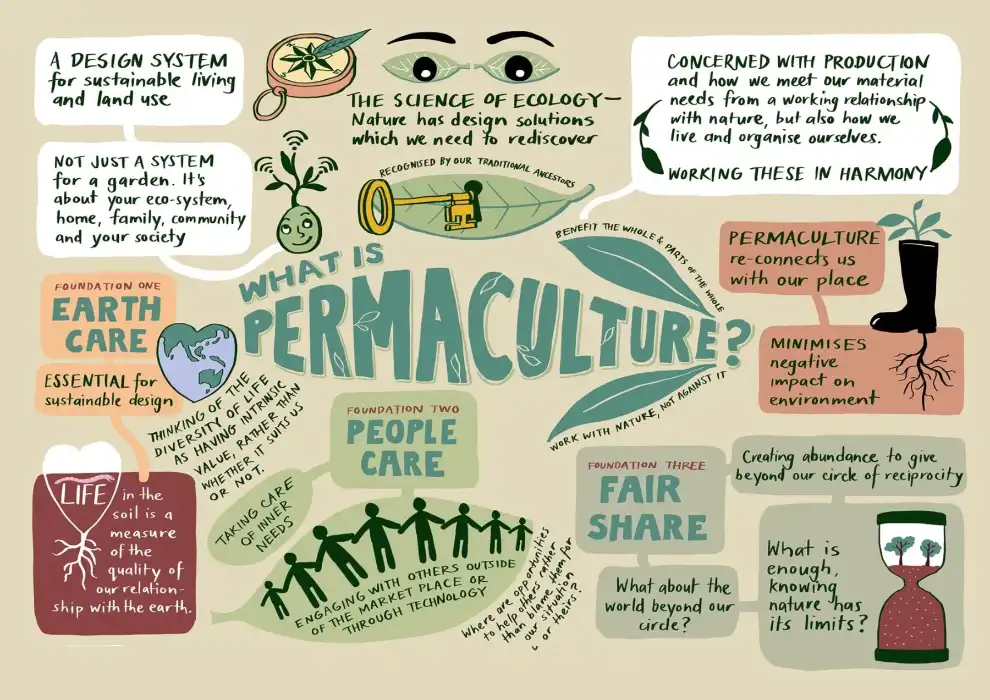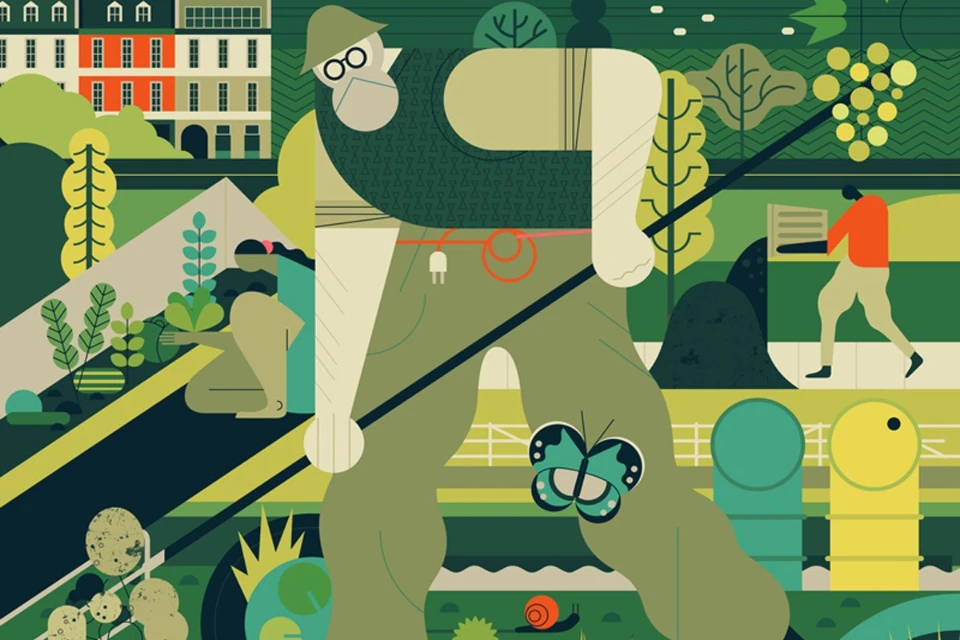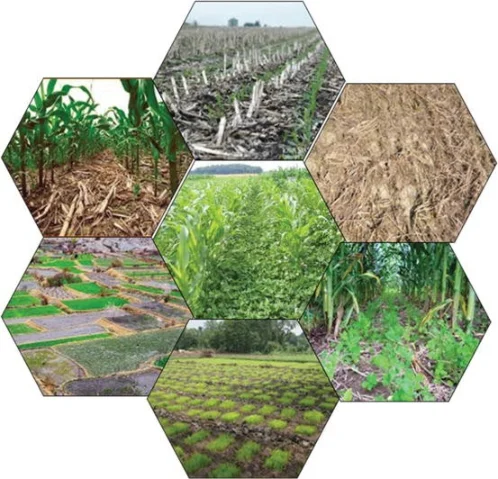Permaculture is a term that you may have heard of, but do you know what it actually means? And more importantly, why should you care about it?
It is a design system that aims to create sustainable and harmonious human settlements that work with nature, rather than against it.
This word comes from “permanent agriculture” and “permanent culture”, reflecting the idea that we can create lasting and resilient ways of living on this planet.
It is based on three core ethics: Care for the earth, Care for the people, and Fair share.
These ethics guide the principles and practices of permaculture, which can be applied to any scale, from a balcony garden to a farm, from a community to a city, from a region to a planet.
In this blog post, we will explore some of the benefits and challenges, and how you can get started with it in your own life.

Benefits Of Permaculture
It offers many benefits for both humans and the environment. Some of the benefits are:
Enhances Biodiversity And Ecosystem Health
By mimicking natural patterns and processes, it creates diverse and productive landscapes that support a variety of life forms.
Promotes native plants, resilient to pests, diseases, and climate change. Conserves soil, water, energy, and reduces pollution and waste.
Improves Human Well-being And Social Justice
By caring for the people, a sense of community and cooperation among people who share a common vision and values.
Empowers individuals with skills and tools for self-sufficiency in food, product-making, and income generation.
It also respects the diversity and dignity of all cultures, and promotes the fair distribution of resources and opportunities.
Inspires Creativity And Innovation
By applying the principles and practices, you can unleash your creativity and imagination to design solutions that are appropriate for your context and situation.
Encourage experimentation, learning, and adaptation. Seek feedback from nature and others, fostering curiosity and appreciation for the beauty of life.
Challenges Of Permaculture
It is not a magic bullet that can solve all the problems of the world, and also has its own challenges and limitations, such as:
Requires Time And Effort
It is not a quick fix or a one-size-fits-all approach, it requires a lot of observation, planning, implementation, and maintenance.
Requires continuous learning, unlearning, and adaptability to face new challenges with patience and perseverance amid uncertainty and change.
Faces Resistance And Opposition
It is not a mainstream or conventional way of thinking or doing things and may be seen as radical, unrealistic, or impractical by some people, especially those who benefit from the current system or who are afraid of change.
It may encounter legal, political, or economic obstacles like regulations favoring industrial agriculture. Social and cultural barriers, such as norms or beliefs, may discourage diversity and cooperation.
Not Perfect Or Complete
It is not a fixed or final system, but a dynamic and evolving one. And not a dogma or a doctrine, but a philosophy and a practice, and is not a science or an art, but a combination of both.

How To Get Started With Permaculture
If you are interested in, and want to give it a try, here are some steps that you can take to get started:
Learn More About Permaculture
There are many resources available to help you learn more, such as books, websites, podcasts, videos, courses, workshops, and events.
You can also join online or offline groups, networks, or communities and enthusiasts, where you can exchange ideas, experiences, and support.
Some important examples and resources are:
| Examples of Permaculture | Description |
|---|---|
| Permaculture Principles | A website that explains the 12 principles of permaculture and provides examples and resources for each principle |
| Permaculture | A Designers’ Manual: A book by Bill Mollison, one of the founders of permaculture, that covers the theory and practice of permaculture in depth. |
| Introduction to Permaculture | A free online course by Geoff Lawton, a renowned permaculture teacher and designer, that introduces the basics of permaculture and shows how to apply them in different contexts. |
| Permaculture Podcast | A podcast by Scott Mann, a permaculture educator and activist, that features interviews and conversations with permaculture practitioners and experts from around the world. |
| Permaculture Magazine | A magazine that showcases permaculture projects, stories, and solutions from around the world. |

Observe And Interact With Nature
One of the best ways to learn about is, to observe and interact with nature, and to see how nature works and what nature can teach us.
You can start by observing and interacting with nature in your own backyard, balcony, or neighborhood, or by visiting a nearby park, forest, or farm. And also observe and interact with nature in different seasons, times of the day, and weather conditions.
Some of the things that you can observe and interact with are:
- The sun, the moon, the stars, and the cycles of light and dark.
- The wind, the rain, the snow, and the patterns of weather and climate.
- The soil, the water, the air, and the elements of life.
- The plants, the animals, the fungi, and the diversity of life forms.
- The patterns, the shapes, the colors, and the beauty of nature.
Design And Implement A Permaculture Project
The ultimate way to learn is, to design and implement a permaculture project, and to see the results and impacts of your actions.
You can start by designing and implementing a small and simple project, such as a herb spiral, a worm bin, a compost pile, a rain barrel, a bird feeder, or a bee hotel.
You can also design and implement a larger and more complex project, such as a vegetable garden, a food forest, a chicken coop, a greenhouse, a solar panel, or a water catchment system.
Some of the steps that you can follow to design and implement a project are:
- Define your vision, goals, and objectives for your project, and what you want to achieve and why.
- Observe and analyze your site, and what are the characteristics, resources, and challenges of your site.
- Design your project, and what are the elements, functions, and relationships of your project.
- Implement your project, and what are the actions, materials, and tools that you need to execute your project.
- Maintain and evaluate your project, and what are the feedback, adjustments, and improvements that you need to make to your project.

Conclusion
Permaculture is not only a way of gardening or farming, but a way of living and thinking that can help us create a more sustainable and harmonious world.
It is also a journey of discovery and learning that can enrich our lives and connect us with nature and each other.
Read Also:
Flower Farming: Business, Make Money And Benefits
Palworld Farming: How To Grow And Harvest Food With Your Pals
How To Plant A Peach Seed: And Grow Your Own Peach Tree
What Is O Farming: Make Money Online, Get Start & Benefits
How To Grow Pistachio From Seed: Important Steps, Tips & Tricks

Meet Our Expert Agricultural Administrator
Welcome to agrigreenhands.com, your dedicated hub for all things related to agricultural farming. Leading the way in our commitment to sustainable and innovative practices is Jawad Hussain, our esteemed administrator with a profound background in agriculture….


